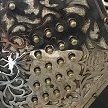Search the Community
Showing results for 'meantone'.
-
I'm looking to tune a concertina in 1/5 comma meantone centered around D and having A as close to 440 as possible. Could someone knowledgeable on the subject explain how to exactly go about this? Was wondering if anyone has a chart of the frequencies in Hz. Or if someone could explain how to create this. I've searched all over and find it generally confusing to understand how to construct it. Do I flatten the 5ths by a syntonic comma in the following order: D-A-E-B-F#-C#-G#-D#-A#-F-C-G ? And then half or double the resultant frequencies into their respective octaves to make up the scales and correct notes on the keyboard? Hoping to wrap my head around this subject. Thank you.
-
I just ran into some fascinating questions on another forum as I was trying to get my head around how to calculate frequencies for a 1/4-comma meantone scale given a reference note. Since Anglos have two "home" keys... Which reference note would I use? on a C/G Anglo, would I use C as the reference for the whole thing? OR, would I use C for the C row, and G for the G row? OR would I use C for the C row and THEN use the C row's G as the reference note for the G row? Or something else? and what about the accidental row? Is there some standard way of tuning an Anglo to 1/4-comma? Or does everyone have their own preferred way?
-
I am currently at the stage of tuning the reeds for a new Anglo concertina. I have been reading, on this forum and elsewhere, on the various meantone tunings peope are using, especially on Engish concertina. I have the data I need for ET, 1/4 Comma and 1/5 Comma cent offsets, and I would like to know whether they offer any advantage in group playing. The tuner I use has the capabity to play chords and instantly switch to any other tuning. To my ear 1/5 Comma sounds much more harmonious than 1/4 Comma or ET; the 3rds and 6ths benefit greatly from the lack of beating. Would there be any benefit in applying meantone tuning to an Anglo to be mainly played in sessions/with other instruments? Your comments and insights would be appreciated. Mike
-
This is a long shot, but... Has anyone managed to configure Thumbjam to play 1/5 comma meantone? If so, how did you do it? Thx. Don. Background (warning - rather geeky/anoraky) Thumbjam is a midi synthesizer/sampler app for iOS (iPad/iPhone). Michael Eskin donated his concertina sound samples to the developer of Thumbjam so you can play Michael's concertina sounds in Thumbjam. Major thirds on this system sound like major thirds on a real concertina. So I thought that this would be a good platform to experiment with meantone temperament. Thumbjam, being a synthesizer/sample player, can change the pitch of notes being played. There are very many scales/temperaments provided in Thumbjam besides ET and the common western scales but, AFAICT, no meantone temperaments. However, you can enter your own scales and, I think, temperaments. Thumbjam recommends a program called Scala to do this. I think, but I am not sure, that I can see a way to do this, but it is going to take me some time to figure it out so I am hoping that just maybe somebody else has been down this road already.
-

Quarter Comma Meantone - What Root Note?
Terry McGee posted a topic in General Concertina Discussion
A friend is porting Flutini, the real time tuning analyser, to iPod. I recounted that I'd found it useful for checking concertina tuning, and that some concertina players have gone for quarter comma meantone rather than equal temperament, so that if he were intending to offer some temperaments, that would be a potentially useful one. He agrees but asks what root note the temperament should be centred on. Do we have a firm view on this? Terry- 37 replies
-
- Temperament
- meantone
-
(and 1 more)
Tagged with:
-
There's been a lot written about meantone tuning recently on this forum, but I don't think there are any practical audio comparisons. Since I have anglos in both ET and ¼ comma meantone, I've recently made a short youtube movie to demonstrate and hopefully demonstrate the difference. Unfortunately, I only have Bb/F anglos in both temperaments, so the recording will sound a tone lower than most people would be used to. I've selected four contrasting sorts of pieces and edited the video so that the differences can be directly heard. I've discussed some of the issues, so it is a bit on the long side, but I do hope it will help anybody who is unsure of the scale of difference between the two. https://www.youtube.com/watch?v=HT9fStxlbBQ&feature=youtu.be Adrian
-
I have just recieved my new wooden-ended Aeola TT from Theo Gibb. Apart from doing a brilliant job of restoration he has tuned it in 1/5 comma meantone for me. I am not aware of having heard an ec in this tuning before and I was apprehensive about doing it. After consulting on here I decided to go ahead and am glad I did. Chords are definately sweeter and more rounded with no harsh heterodyne beating, at least in the keys I normally play in. When there is any slight discord it is no worse than an instrument in ET (eg f#maj, a chord I never use). On the whole I am very pleased with this tuning and would recommend it to anyone who has doubts.
- 44 replies
-
As you may recall I have recently rebuilt a previously derelict brass-reeded Aeola TT (as featured in my avatar). Having played this in for a while, I'm getting a feel for how the instrument plays and how it sounds. I'm already being inspired to work on more song accompaniment - the reeds' sound is rich and mellow, but not as loud as a steel-reeded 'tina, so I'm thinking it will be great for song accompaniment. It may not hold its own in a session - I can use my metal-ended steel-reeded Aeola TT for that. At the moment it is tuned to philharmonic pitch and I've just started to retune it to modern concert. But Geoff Wooff's meantone description of one of his 'tinas in another thread set me thinking could this be something I should consider for this instrument. What are the advantages & disadvantages of tuning to meantone? How might this sound in chords used for song accompaniment? (I have one song in mind that I think suits the key of Cm)? What about playing together with other instruments - fiddle, harp? What effect on playing technique might I expect? I guess also that having spent many years assuming that that D#/Eb are the same notes (and G#/Ab), playing meantone may take some getting used to. I suppose when reading a Eb or Ab in b-keys I play those notes, and not their # equivalents as I might otherwise have done. Similary when playing in #-keys I play the # notes and not the b equivalents. Thanks, Steve
-
Hi all - hope someone can advise me. I am restoring a 20 key CG Lachenal Anglo circa 1885 and have got to the stage of tuning. The pitch seems to be somewhere around A447 and as far as I can tell the tuning is closer to quarter comma meantone than anything else. So rather than attempting retune the whole thing to ET A440, I have decided to use what seems to be the original tuning. Since I want to use it mainly to accompany myself singing and to practice and improve my playing skills this seems like a good choice. So far I have tuned the G row using G as the root note and it sounds very sweet to my ears. My question is, should I use C as the root note when I tune the C row, or would it be better to stick with G for the whole instrument, so that there is no variation in pitch when playing across the rows? If anyone has any experience of doing this or understands the theory well enough to explain it to a poor amateur folk singer who does everything by ear, I would be very grateful to hear you words of wisdom.
-
I've got some decisions to make on an 1850s Wheatstone that appears to be still in an original Meantone tuning, and I thought I'd open them up for discussions. The instrument in question is from Greg Jowaisas' Pyramid Sale, with brass reeds and unbushed bone buttons. The first questions have to do with the buttons. I have to admit, I don't like the appearance of the dyed buttons, with black buttons for accidentals and red buttons for C. Options would include replacing the C's with undyed buttons, or possibly replacing all of the buttons. And then there is the question of whether or not to bush the buttons. Either change would deviate from the original historic state of the instrument (including what appear to be the original bellows), one purely cosmetic, and the other affecting the playing quality. I'm torn between restoring an historic instrment as closely as possible, and improving it (for personal definitions of improve). The second questions would be, what meantone tuning was it in. Time permitting, I believe Greg will be posting the current reed information (it is not in tune with itself at present, but notes which would be enharmonic in Equal Temperment are consistently off indicating some form of Meantone), if anyone is willing to weigh in on what the tuning looks like, that would be great.
-
Moved to General Discussion
-
http://hmi.homewood.net/meantone Take a look and listen to this one. This tuning is by request of course, I have heretofore only used equal temperment note cents diff. C +10 C# -14 D +3 D# -21 E -3 F +14 F# -10 G +7 G# -17 A 0 A# -24 B -7
-
But I'm going to anyway. If anyone runs across an English concertina that is still in the original Meantone temperment (so this would apply to the oldest of the Englishes, before they switched over to Equal Temperment) for sale, please let me know.
-
FOLKS: When giving a lecture-recital, I regularly play on two instruments that date from the mid-1850s. One of these, 6760, has steel reeds (surely not original) and is tuned with equal temperament (probably also not original). The other, 5899, still has both its original brass reeds and its meantone tuning. I strongly suspect that most of the instruments that date from that period and with which we occasionally come into contact were, in fact, tuned in meantone and have since been brought into line with equal temperament. I don't find that at all unsual. Allan



.thumb.jpg.23b6fcf34553f5a5db9b762a831724d9.jpg)


.thumb.jpg.e5ef9a111c1064c0bbea848f22aab7fe.jpg)

